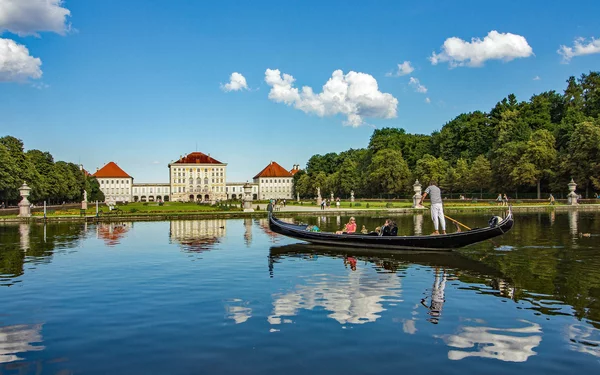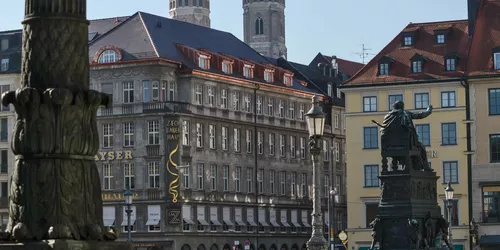Discover the Munich way of life
Explore Munich on two wheels. Discover the architecturally impressive Königsplatz on this cycle tour and be enchanted by the majestic Nymphenburg Palace.
München
5 h
20 km
Munich is the secret cycling capital of Germany. Well-developed cycle paths, flat routes, culture, history, vibrancy, lots of greenery, culinary temptations along the way - this city offers everything your heart desires. This circular cycle tour will give you a good insight into Munich's history and way of life, an overview of the city's layout and sights.
You can conveniently hire your bike from Radius Bikes at the railway station.
The tour is easy to cycle.
A cycle tour for culture lovers and connoisseurs
Arrive relaxed and hire bikes from local hire companies. The capacity for taking bikes on the trains is limited and, depending on capacity utilisation, taking your own bike on board cannot be guaranteed.
Start and end station
München Hbf
20 km / 5 Stunden
München Hbf
Our tip: Please make sure to check your train connection and the expected capacity before you start your journey.
Schedule
Tour starts on München Hbf
Direction
DB Bicycle Service Hbf. Munich
At Munich Central Station there are Call a Bike stations on the north side in Arnulfstraße and on the south side of the station in Bayerstraße. You will also find numerous Call a Bike bicycles in the immediate vicinity of the station, independent of the station.
There are 352 bicycle parking spaces in the immediate vicinity of the station.
Bayerstr. 10a
80335
München
Direction
Bike hire is available at the main station opposite platform 32.
Radius Bikes
Whether e-bikes, city bikes, sports bikes or children's bikes - Radius Bikes has everything visitors need to "conquer" Munich on a hire bike. The city is considered the secret cycling capital anyway, has a wonderfully developed network of cycle paths, is flat and offers relatively short distances.
There are over 250 bikes in the shop. Bicycle baskets, air pumps, repair kits and city maps are provided free of charge. Panniers, child seats and helmets are available for a small surcharge. Rental costs between 18 and 38 euros per day plus any extras you may require.
Interested parties can book their hire bikes in advance on the homepage or enquire by telephone.
Arnulfstr. 3
80335
München
Direction
From Arnulfstraße, keep northwards, follow Luisenstraße and after eight minutes you will have reached your first tour highlight.
Königsplatz
Königsplatz was laid out in 1806. Architecturally, it is closely linked to the entire Maxvorstadt area and especially Brienner Strasse, the former Wittelsbacher Fürstenweg. The master builder Karl von Fischer wanted to break up the strict classical order of the boulevard with squares and green spaces. He modelled the design of Königsplatz on the ancient Acropolis.
During the Nazi era, Brienner Strasse and Königsplatz underwent numerous changes, so that the original character was alienated. Königsplatz in particular was used for Nazi marches and book burnings. The former design of the square was completely reversed. All greenery was removed and Nazi-style buildings were erected. The entire square was paved with huge granite slabs. During the air raids towards the end of the war, the square was covered with tarpaulins painted to simulate dense residential development. Nevertheless, the neoclassical buildings in particular were badly damaged.
In 1987/88, Königsplatz was almost restored to its original aesthetic.
Today, the square is used for open-air concerts, festivals and demonstrations.
The buildings house art collections and museums.
Königsplatz
80333
München
Direction
The following journey along the Nymphenburger Straße is a taste of Munich's lifestyle and flair. The road has been an important trade route since the 12th century and was known as the Fürstenweg, as it led directly to Nymphenburg Palace. You cycle past Grünwaldpark and the Hubertusbrunnen fountain, finally arriving at Nymphenburg Palace on an idyllic route along the banks of the canal.
Nymphenburg Palace
In view of the gigantic size of the Nymphenburg Palace complex, it is hard to imagine that all this once emerged from a single small country house, which was roughly the size of one of the later side buildings. Today, the north-south axis measures 632 metres. Nymphenburg Palace is therefore larger than Versailles Palace.
The palace park is 180 hectares in size. It was laid out around 1700 in the French Baroque style. Beginning in the southern part of the park, the park was altered a hundred years later in the style of an English landscape park and the extensive grounds are now a major visitor attraction. The smaller castles in the park, the park castles (Amalienburg, Badenburg, Magdalenenklause, Pagodenburg) are also popular with visitors. They are built in the rococo style and are regarded as artistic gems.
Guided tours of the palace's museum rooms, the Marstall Museum with its fleet of carriages and the Nymphenburg Porcelain Museum convey the courtly way of life.
The northern part of the palace is home to the Museum Mensch und Natur, Munich's natural history museum.
The palace and the park castles are barrier-free and guided tours are also available in simple language.
Schloss Nymphenburg 1
80638
München
Direction
After so much splendour and magnificence, you may be thirsty for a nice place to stop for a bite to eat in the countryside. After cycling north-east along the Nymphenburg-Biedersteiner Canal, take a short detour towards the Taxisgarten at Taxisstraße 12. Since 1924, you can enjoy a relaxed cosiness here in the shade of majestic trees. There is a playground for children and probably the best spare ribs in town for hungry stomachs. Open Monday to Saturday from 12:00 in good weather and from 11:00 on Sundays and public holidays.
Strengthened and refreshed, you can now continue on to the Olympic Park.
Olympic Lake
The Olympic Lake was created with the Olympic Park in 1972 and forms an extension of the Nymphenburg-Biedersteiner Canal. The lake has a total area of 8.6 hectares. Its widest point measures 200 metres. It is only 1.3 metres deep on average. It is fed by water from the canal and receives rainwater from the roofs of the Olympic Stadium. At the same time, a weir helps to collect the water that accumulates on sealed surfaces and release it into the canal in a controlled manner. This prevents flooding.
The lake is a stopover for many migratory birds and is a popular destination for excursions and cultural events.
Stars and celebrities have immortalised themselves with a handprint on the promenade below the Olympic Tower, including the Dalai Lama, Tom Jones, Elton John and Liza Minnelli, Bon Jovi, Metallica, Genesis, Die Toten Hosen, B.B. King, Aerosmith, Kiss, R.E.M. and The Undertaker.
Olympiasee
80809
München
Direction
The route now continues north-eastwards along the Petuelring. An ingenious urban planning solution is the Petuelpark, which is located on a tunnelled section of the ring road. A garden for self-planting, playgrounds, an art exhibition and a café make it a popular local recreation area for residents and visitors alike.
Leopoldstraße takes you past Münchener Freiheit. On Geiselstraße you will come across the Walking Man, a huge sculpture by New York artist Jonathan Borofsky. From here you can walk directly to the Siegestor.
Victory Gate
The architect Friedrich von Gärtner designed and planned the Siegestor. He modelled it on the Arch of Constantine in Rome. The Siegestor was built between 1843 and 1850 and is now a Munich landmark. It marks the border between the districts of Schwabing and Maxvorstadt. The quadriga that adorns the gate shows the Bavaria leading a team of four lions.
After it was severely damaged in the Second World War and then rebuilt, the following inscription was added to the gate: "Dedicated to victory, destroyed by war, admonishing peace."
Siegestor
80539
München
Direction
Your route continues southwards across Odeonsplatz, which was named after the concert hall that King Ludiwg I once had built here. After the Second World War, it was converted into the Ministry of the Interior. You cycle past the Hofgarten, a 400-year-old park, and arrive at Max-Joseph-Platz.
Max-Joseph-Platz
The bronze monument in the centre of the square depicts Maximilian I Joseph of Bavaria. The square was named after him. After a Franciscan monastery was demolished here in 1802 to make room for a new national theatre, the architect Leo von Klenze designed this square. Today it is home to the Königsbau with the Academy of Fine Arts, the Residenztheater with the Bavarian State Theatre, the Bavarian State Opera in the National Theatre and the Palais Toerring-Jettenbach. The appearance of the square was changed with the construction of an underground car park in 1963. Nevertheless, thanks to the well-preserved buildings, much of the former charm can still be felt. The opera festival has been broadcast here regularly since 1990.
Max-Joseph-Platz
80539
München
Tour ends on München Hbf
Direction
Now make your way back to Munich Central Station. You will pass the Wittelsbach Fountain, the impressive monumental fountain in Munich city centre. It symbolises the elemental forces of water and was built according to plans by the sculptor Adolf von Hildebrand.
From here it is just 4 minutes to the main railway station and your bike hire. You will find numerous opportunities to end the day with a good meal around the station. Including Munich's oldest beer garden. The Augustiner Keller is just an 8-minute walk from the main railway station at Arnulfstr. 52, 80335 Munich; phone: 089 - 594 393. Beer garden and restaurant, one of the two is open daily from 10:00 to 0:00.





















